DECEMBER last year, four Malaysian workers died in a fire at a Geylang walk-up apartment. It was Singapore's worst fire in a decade.
Tragedy repeated itself on Friday last week, barely 200m from the earlier blaze. This time, two construction workers from Bangladesh died.
In both cases, old Geylang walk-up apartments were turned into overcrowded foreign worker dormitories, becoming death traps when they caught fire.
How many foreign workers have to die before something is done? That the workers had died from a "Third World" cause, like a fire, in "First World" Singapore ought to prick the conscience of people here, especially that of the parties involved in housing foreign workers. These parties are, first, landlords who allow their premises to be turned into cramped quarters.
In last week's fire, the landlords, a Singaporean couple who gave their names only as Mr and Mrs Bala, told reporters that their tenancy agreement had limited the number of tenants to "eight or 10", but admitted that they did not carry out checks. Such a mentality cannot absolve landlords of their responsibilities.
Then there are the middlemen who make a quick buck from illegal subletting. In the latest fire, the Singaporean landlords had rented their apartment to a master tenant for $3,200 a month.
The master tenant - an unidentified foreigner here on a work permit - then partitioned the unit and reportedly rented out beds to more than 30 workers for more than $200 each, or at least $6,000 in total.
Second, employers who do not take full responsibility for their workers' living conditions also cannot be let off the hook.
The employer of the two workers killed last Friday, Mr Thanapalan Vijayan of Prower Tech Engineering Services, told The Sunday Times that he was unaware of the cramped living conditions. Apart from the two who died, four more of his workers also lived in the unit. How can he be unaware of this?
The work permit rules of the Ministry of Manpower (MOM) make employers who hire foreign workers responsible for housing them.
Last but not least, the government agencies in charge of enforcing rules on housing foreign workers should also take responsibility.
The rules are clear: MOM says housing standards must be "acceptable". According to Urban Redevelopment Authority (URA) guidelines, rented residential properties can house only a maximum of eight people, regardless of size.
"Premises that house more than eight workers are considered to have been illegally converted into a workers' dormitory," the MOM warns on its website.
But these rules and warnings matter little if they are not enforced. The URA said it has investigated 180 cases of unauthorised workers' dormitories at Geylang since December last year. It may be the tip of the iceberg.
In terms of fire safety inspections, the Singapore Civil Defence Force (SCDF) clearly could have done better in last week's blaze. It did turn up at the Geylang Lorong 6 apartment for a surprise check in February, but the door was locked. SCDF then wrote to the owner to say another check will be done on March 25.
This is as good as tipping off the owner. The foreign workers moved out before the inspection and went back the same day, said an eyewitness.
If the authorities lack the resources to run checks - a common refrain - why not consider outsourcing? After all, the MOM has already outsourced some enforcement checks to retired policemen.
After the fire last December, MOM and URA were reported to be reviewing the guidelines on subletting private residential premises to foreign workers. It is unclear what became of the review.
Investigations are understood to have been completed but we still do not know why the fire started and if anyone will be hauled to court.
To stop the problem of illegal subletting, a good place to start is to make an example of those who flout the rules. If landlords face jail for renting out their premises to illegal immigrants, why can't they be held responsible when their premises are turned into illegal dormitories?
The middlemen and employers who house their workers in these illegally converted dormitories should also be punished.
No fewer than six government agencies are responsible for foreign workers' housing.
Besides the MOM, URA and SCDF, the Building and Construction Authority, the National Environment Agency and PUB are also involved. With the much-vaunted whole-of-government approach behind this issue, expectations are high for something to be done.
And the top priority is to ensure that the living quarters of foreign workers are not overcrowded such that they become death traps when a fire breaks out. This must be done before the dead bodies pile up higher.

